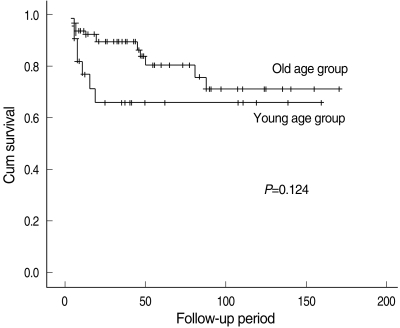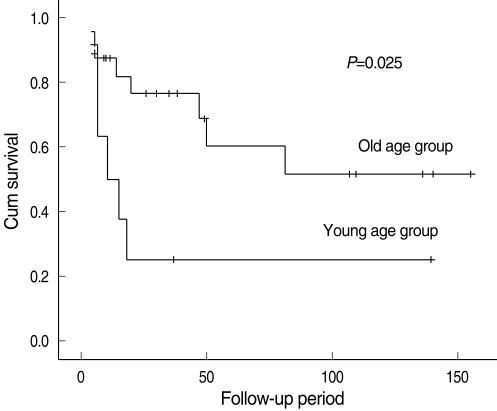Clin Exp Otorhinolaryngol.
2010 Sep;3(3):161-165.
Clinical Outcome of Squamous Cell Carcinoma of the Tongue in Young Patients: A Stage-Matched Comparative Analysis
- Affiliations
-
- 1Department of Otolaryngology-Head and Neck Surgery, The Catholic University of Korea School of Medicine, Seoul, Korea. entkms@catholic.ac.kr
Abstract
OBJECTIVES
The reported incidence of tongue cancer in young patients has recently increased. The aim of this study was to analyze the clinical characteristics of tongue cancer in a young group of patients, and to compare them with those of an older group of tongue cancer patients.
METHODS
We retrospectively reviewed the records of 85 patients who were diagnosed with squamous cell carcinoma of the tongue. They were divided into two age groups: over 45 years of age and under 45 years. To compare the prognosis of similarly staged patients in the group, each age group was divided into the early (stage I, II) and advanced stage groups (stage III, IV), and then they were compared. The young group consisted of 23 patients and the older group had 62 patients.
RESULTS
At the early stage, the clinical prognosis of the patients in both age groups was good, and no significant difference was observed. However, at the advanced stage, the overall and regional recurrence rates were significantly higher in the younger age group as compared to that in the old age group (P=0.007, P=0.001, respectively). The disease-specific survival rate of the patients in the young group was significantly lower than that in the old age group (P=0.025).
CONCLUSION
Tongue cancer in young subjects has significantly different clinical outcomes according to the stage. The clinical outcome of the advanced-stage tongue cancer in young subjects was poorer than that in the older subjects. Regional recurrence seemed to be the main cause of the poor prognosis.
Keyword
MeSH Terms
Figure
Reference
-
1. Parkin DM, Pisani P, Ferlay J. Estimates of the worldwide incidence of eighteen major cancers in 1985. Int J Cancer. 1993; 6. 54(4):594–606. PMID: 8514451.
Article2. Son YH, Kapp DS. Oral cavity and oropharyngeal cancer in a younger population: review of literature and experience at Yale. Cancer. 1985; 1. 55(2):441–444. PMID: 3965099.
Article3. Chitapanarux I, Lorvidhaya V, Sittitrai P, Pattarasakulchai T, Tharavichitkul E, Sriuthaisiriwong P, et al. Oral cavity cancers at a young age: analysis of patient, tumor and treatment characteristics in Chiang Mai University Hospital. Oral Oncol. 2006; 1. 42(1):83–88. PMID: 16249113.
Article4. Hollows P, McAndrew PG, Perini MG. Delays in the referral and treatment of oral squamous cell carcinoma. Br Dent J. 2000; 3. 188(5):262–265. PMID: 10758688.
Article5. Amsterdam JT, Strawitz JG. Squamous cell carcinoma of the oral cavity in young adults. J Surg Oncol. 1982; 2. 19(2):65–68. PMID: 7057649.
Article6. Sasaki T, Moles DR, Imai Y, Speight PM. Clinico-pathological features of squamous cell carcinoma of the oral cavity in patients <40 years of age. J Oral Pathol Med. 2005; 3. 34(3):129–133. PMID: 15689225.7. Friedlander PL, Schantz SP, Shaha AR, Yu G, Shah JP. Squamous cell carcinoma of the tongue in young patients: a matched-pair analysis. Head Neck. 1998; 8. 20(5):363–368. PMID: 9663661.
Article8. Pitman KT, Johnson JT, Wagner RL, Myers EN. Cancer of the tongue in patients less than forty. Head Neck. 2000; 5. 22(3):297–302. PMID: 10748455.
Article9. McGregor GI, Davis N, Robins RE. Squamous cell carcinoma of the tongue and lower oral cavity in patients under 40 years of age. Am J Surg. 1983; 7. 146(1):88–92. PMID: 6869685.
Article10. Clark RM, Rosen IB, Laperriere NJ. Malignant tumors of the head and neck in a young population. Am J Surg. 1982; 10. 144(4):459–462. PMID: 7125078.
Article11. Hafkamp HC, Manni JJ, Speel EJ. Role of human papillomavirus in the development of head and neck squamous cell carcinomas. Acta Otolaryngol. 2004; 5. 124(4):520–526. PMID: 15224887.
Article12. Hart AK, Karakla DW, Pitman KT, Adams JF. Oral and oropharyngeal squamous cell carcinoma in young adults: a report on 13 cases and review of the literature. Otolaryngol Head Neck Surg. 1999; 6. 120(6):828–833. PMID: 10352435.
Article13. Popovtzer A, Shpitzer T, Bahar G, Marshak G, Ulanovski D, Feinmesser R. Squamous cell carcinoma of the oral tongue in young patients. Laryngoscope. 2004; 5. 114(5):915–917. PMID: 15126756.
Article14. Atula S, Grenman R, Laippala P, Syrjanen S. Cancer of the tongue in patients younger than 40 years: a distinct entity? Arch Otolaryngol Head Neck Surg. 1996; 12. 122(12):1313–1319. PMID: 8956742.
Article15. Lingen MW, Chang KW, McMurray SJ, Solt DB, Kies MS, Mittal BB, et al. Overexpression of p53 in squamous cell carcinoma of the tongue in young patients with no known risk factors is not associated with mutations in exons 5-9. Head Neck. 2000; 7. 22(4):328–335. PMID: 10862014.
Article16. Sorensen DM, Lewark TM, Haney JL, Meyers AD, Krause G, Franklin WA. Absence of p53 mutations in squamous carcinomas of the tongue in nonsmoking and nondrinking patients younger than 40 years. Arch Otolaryngol Head Neck Surg. 1997; 5. 123(5):503–506. PMID: 9158397.
Article
- Full Text Links
- Actions
-
Cited
- CITED
-
- Close
- Share
- Similar articles
-
- A Case of Basaloid Squamous Cell Carcinoma Occurring in the Mobile Tongue
- Expression of E-Cadherin and Matrix Metalloproteinase-2 in Squamous Cell Carcinoma of the Oral Tongue
- Glossopharyngeal Neuralgia Secondary to Tongue Squamous Cell Carcinoma
- Clinical Outcome of the Squamous Cell Carcinoma of Tongue: Experience of National Cancer Center
- Expression of CD44, MMP-2, MMP-9 and TIMP-1 in tongue squmous cell carcinoma




